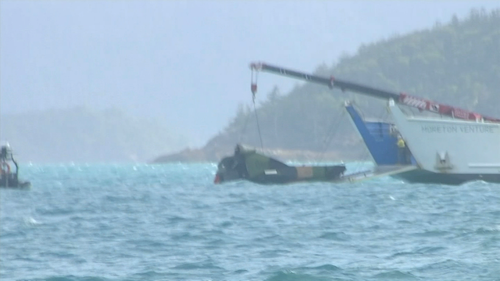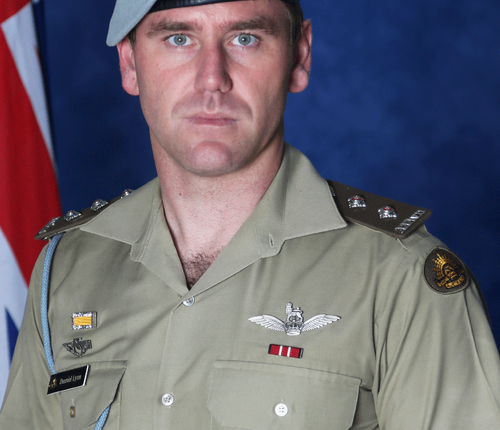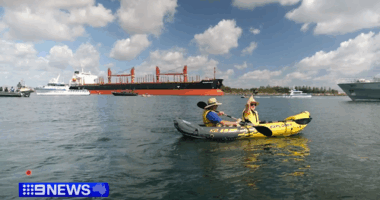Share this @internewscast.com
A last second evasive manoeuvre by an Army pilot saved the lives of four other airmen, according to military air safety investigators.
The DFSB has attributed the fatal Army helicopter crash to spatial disorientation, with Defence investigators determining that the advanced helmet used by the pilots during night-time flights likely did not contribute to the accident, even though the equipment presented an evident “hazard”.
“It’s getting dicey,” Captain Lyon is heard saying to co-pilot Lieutenant Max Nugent on the cockpit voice recorder, just five seconds into a left-hand turn while flying in a staggered formation with three other Taipan MHR-90 helicopters.
Their helicopter, designated Bushman 83, had encountered rain showers prompting Lyon to take control from Nugent due to the worsening conditions at 10:33pm and 34 seconds.

“I’ll just get around the corner for you mate⦠while we’re dealing with the rain shower,” he tells Nugent.
At 10:36:04, two and a half minutes after Lyon took the controls of Bushman 83, it started to climb, from 224ft to a maximum of 362ft, 14 seconds later.
Nine seconds into the climb, with the Taipan at 320ft, Lyons says to Nugent: “Have you still got em?” referring to Bushman 82, the aircraft flying ahead of them in the formation, to the right.
Nugent replies calmly: “Yeah, still get em mate.”
DFSB investigators believe it was at this point that Lyon lost sight of Bushman 82. He quickly rolled the aircraft 31 degrees right before quickly rolling back left 8 degrees to establish a visual of the other aircraft.

Neither Lyons nor Nugent appeared to have noticed that during the climb, the orientation of aircraft shifted from 5 degrees nose up to 5 degrees nose down â a 10 degrees shift.
At 10:36:19, Bushman 83 reached the top of its climb, now much higher than the three other helicopters in the formation. It is six seconds from disaster.
Unaware that the pitch attitude had shifted from nose up to nose down, Lyon used the controls to pitch down, exacerbating the so-called “pushover”.
The aircraft went into a quickening descent, hitting the water at 10:36:25 â 21 seconds after it began to climb.
When it hit to water it was travelling at 259kmh. Lyon, Nugent and aircrew Warrant Officer Phil Laycock and Corporal Alex Naggs were killed instantly.
The DFSB report found that in the split seconds before the crash, when the aircraft was in its fatal plunge, Lyon realised Bushman 83 was at risk of crashing into Bushman 82 and took immediate diversionary steps, rolling the aircraft to the right.

“During the two and a half seconds after the pushover, (flight data recorder) analysis indicates that the relative distance between the two aircraft decreased from approximately 100 metres to 50 metres,” the DFSB report says.
“In response to this increasing closure, it is likely (Lyon) acted to avoid a potential mid-air collision with BSMN 82 by executing an avoidance turn to the right.”
Lyon’s actions in these last seconds, when his own aircraft was “not recoverable”, likely saved the lives of the four airmen in Bushman 82.
Since the July 2023 crash there has been much focus on the hi-tech TopOwl helmets used by the pilots that night.
The latest software upgrade for the TopOwl, HMSD v5.10, was found to carry significant risks, according to an experienced test pilot with the Army Aviation Test and Evaluation Section (AATES).
The test pilots found that the helmet was a “substantial risk of multiple deaths” and an “unacceptable risk to flight safety” because when pilots looks to the left or the right, the pitch and roll displays inverted.
Despite this stark warning, TopOwl 5.0 was put into service when Army Aviation conducted its own tests in benign conditions, finding it safe to deploy.
DFSB confirmed that TopOwl had its problems but said it was likely not responsible for Lyon becoming spatially disoriented.
“While both AATES and Standards Section test and evaluation reports agreed that there were deficiencies relating to attitude presentation, the two agencies disagreed on the severity of the hazard,” DFSB said.
“Regardless, the investigation determined that it was very unlikely the known hazards relating to the HMSD v5.10 contributed to the loss of Spatial Orientation.
This conclusion was based on the Line of Sight of the BSMN 83 pilots, which was slightly offset from the aircraft’s longitudinal axis, and that the pilots were likely looking ‘through’ the HMSD symbology to maintain attentional focus on BSMN 82.”














